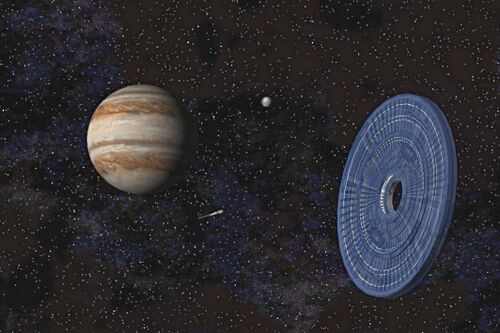Diskworlds (A1-0)
This article needs to be updated. The reason given is: Missing categories and incorrect formatting. (May 2024) |

Image from Steve Bowers on Orion's Arm.
Diskworlds are ring-shaped habitats that enclose nearly their entire diameter to provide an extensive and diverse habitable volume. Aside from a common (but not universal) open cylindrical space at the center of the disks for docking spacecraft, virtually the entire volume of the rings is enclosed and used for a variety of purposes.
Structure
Diskworlds are typically constructed out of Diamondoid, Carbon Nanotube Buckytube and/or other highly resistant materials. They are usually similar in size to Bishop Rings: however, they can can get much larger thanks to the fact that they don't spin, and therefore the stress applied on the construction materials is far smaller. Diskworlds are very diverse, and depending on their intended purpose, they can be vastly different from one another. Some Diskworlds may have multiple levels of habitation extending inward from the outer rim, the exact number of which depends on the distance between one layer and another: on the largest habitats, planetary scale (millions of square kilometers) or even larger living areas are possible. Some may instead have a single large habitable volume extending from the outer rim to the innermost section with bracing structures running from edge to edge. Airwalls, transparent separation membranes and other similar environmental systems work to maintain an even level of air pressure throughout the structures, which often support large aerial and arboreal ecosystems, and are often home to flying or gliding sentient and sapient populations, who most of the time have been artificially adapted to live in zero-gravity. Certain Diskworlds may instead be partially or completely be constructed out of Computronium and the related support infrastructure, hosting large virtual populations: Computronium Diskworlds are more often found orbiting other megastructure-sized processing substrates, such as Jupiter Brains, Matryoshka Micronodes, Moon Brains and planets outfitted with BioGeoComputers. Lastly, some Diskworlds have a fractal honeycomb of chambers, varying in size from meters to hundreds of kilometers across. Individual chambers or groups of chambers are designed to serve whatever purpose is desired, from manufacturing, to urban centers, to nature reserves, and more.
It's however not uncommon for Diskworlds to be a combination of all of the above options and more, depending on the kinds of populations and/or purposes the Diskworld is characterized by.
Internal Environments
While some do have internal artificial gravity, most Diskworlds host Zero Gravity Environments. These environments can be very different from one another, but most are either:
- Aerieal, with large populations of flying, gliding and floating sapients and animals, in some cases accompanied by atmospheric variants of Dyson Trees (like Asterisk Trees or small Orwoods) and other flora adapted to 0 g. Due to the ease at which spores spread, many Diskworlds have layers with fungus and mycelium-based environments.
- Aquatic, with large populations of swimming sapients and animals, accompanied by engineered coral reefs, kelp forests and other flora who was able to grow much bigger due to the absence of gravity, with the water being kept at a uniform pressure by systems similar to those used for atmospheric pressure control.
Internal illumination can be achieved through a variety of methods: self-orienting mirrors, fusion-powered luminaire arrays, often coupled with Bioluminescent Flora are some of the most common examples.
Diskworlds In Sector A1-0
Sources
Orion's Arm: https://www.orionsarm.com/eg-article/4a3a4277520cc